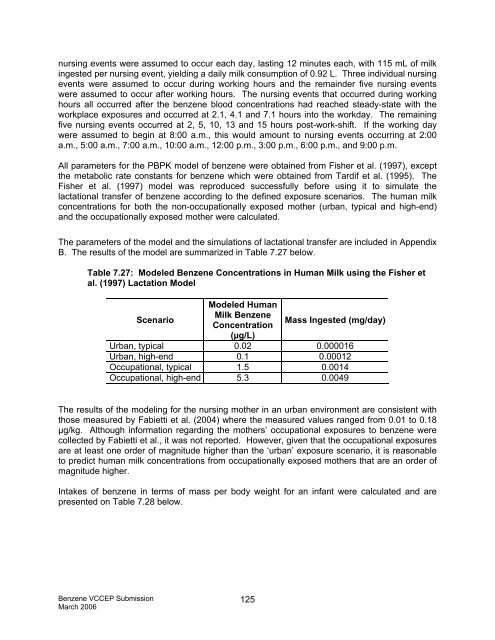(VCCEP) Tier 1 Pilot Submission for BENZENE - Tera
(VCCEP) Tier 1 Pilot Submission for BENZENE - Tera
(VCCEP) Tier 1 Pilot Submission for BENZENE - Tera
You also want an ePaper? Increase the reach of your titles
YUMPU automatically turns print PDFs into web optimized ePapers that Google loves.
nursing events were assumed to occur each day, lasting 12 minutes each, with 115 mL of milk<br />
ingested per nursing event, yielding a daily milk consumption of 0.92 L. Three individual nursing<br />
events were assumed to occur during working hours and the remainder five nursing events<br />
were assumed to occur after working hours. The nursing events that occurred during working<br />
hours all occurred after the benzene blood concentrations had reached steady-state with the<br />
workplace exposures and occurred at 2.1, 4.1 and 7.1 hours into the workday. The remaining<br />
five nursing events occurred at 2, 5, 10, 13 and 15 hours post-work-shift. If the working day<br />
were assumed to begin at 8:00 a.m., this would amount to nursing events occurring at 2:00<br />
a.m., 5:00 a.m., 7:00 a.m., 10:00 a.m., 12:00 p.m., 3:00 p.m., 6:00 p.m., and 9:00 p.m.<br />
All parameters <strong>for</strong> the PBPK model of benzene were obtained from Fisher et al. (1997), except<br />
the metabolic rate constants <strong>for</strong> benzene which were obtained from Tardif et al. (1995). The<br />
Fisher et al. (1997) model was reproduced successfully be<strong>for</strong>e using it to simulate the<br />
lactational transfer of benzene according to the defined exposure scenarios. The human milk<br />
concentrations <strong>for</strong> both the non-occupationally exposed mother (urban, typical and high-end)<br />
and the occupationally exposed mother were calculated.<br />
The parameters of the model and the simulations of lactational transfer are included in Appendix<br />
B. The results of the model are summarized in Table 7.27 below.<br />
Table 7.27: Modeled Benzene Concentrations in Human Milk using the Fisher et<br />
al. (1997) Lactation Model<br />
Scenario<br />
Benzene <strong>VCCEP</strong> <strong>Submission</strong><br />
March 2006<br />
Modeled Human<br />
Milk Benzene<br />
Concentration<br />
(µg/L)<br />
125<br />
Mass Ingested (mg/day)<br />
Urban, typical 0.02 0.000016<br />
Urban, high-end 0.1 0.00012<br />
Occupational, typical 1.5 0.0014<br />
Occupational, high-end 5.3 0.0049<br />
The results of the modeling <strong>for</strong> the nursing mother in an urban environment are consistent with<br />
those measured by Fabietti et al. (2004) where the measured values ranged from 0.01 to 0.18<br />
µg/kg. Although in<strong>for</strong>mation regarding the mothers’ occupational exposures to benzene were<br />
collected by Fabietti et al., it was not reported. However, given that the occupational exposures<br />
are at least one order of magnitude higher than the ‘urban’ exposure scenario, it is reasonable<br />
to predict human milk concentrations from occupationally exposed mothers that are an order of<br />
magnitude higher.<br />
Intakes of benzene in terms of mass per body weight <strong>for</strong> an infant were calculated and are<br />
presented on Table 7.28 below.





